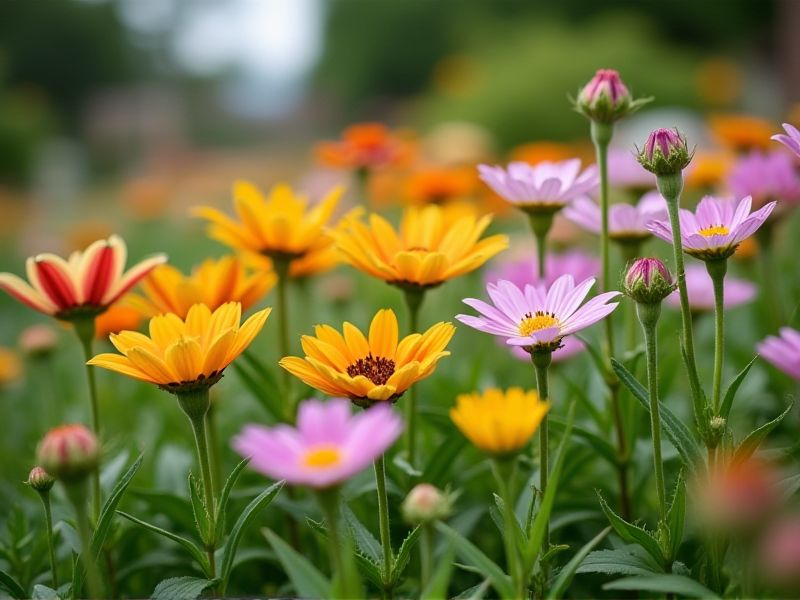
Border plants that bloom continuously can transform your garden into a vibrant, colorful landscape throughout the growing season. Species such as *Coreopsis*, *Echinacea* (coneflower), and *Salvia* not only produce a profusion of flowers but also attract pollinators like bees and butterflies. You might consider perennial varieties, which provide lasting beauty and require less maintenance compared to annuals. Some options, like *Geranium* rozanne, offer long-lasting blooms, while *Lavender* provides both visual appeal and aromatic benefits. Incorporating these flowering plants into your landscape design creates a dynamic and engaging environment that evolves with each season.
List of some Border plants that bloom continuously
- Black-Eyed Susan (Rudbeckia hirta)
- Shasta Daisy (Leucanthemum × superbum)
- Catmint (Nepeta × faassenii)
- Coreopsis (Coreopsis grandiflora)
- Lavender (Lavandula angustifolia)
- Geranium (Geranium Rozanne)
- Salvia (Salvia nemorosa)
- Daylily (Hemerocallis)
- Yarrow (Achillea millefolium)
- Coneflower (Echinacea purpurea)
Important things about Border plants that bloom continuously
Selection Of Perennials
Perennial border plants that bloom continuously provide vibrant color and texture to your garden throughout the growing season. Varieties such as daylilies, echinacea, and salvia are excellent choices, as they produce stunning flowers while requiring minimal maintenance. Incorporating species like heuchera and ornamental grasses can enhance visual interest, creating a lush backdrop for your blooming plants. By strategically placing these perennials in your landscape, you can enjoy a dynamic display that attracts pollinators and retains visual appeal year after year.
Deadheading Techniques
Deadheading is an essential technique for maintaining border plants that bloom continuously, as it encourages new flower growth and prolongs blooming periods. By removing spent blooms, you prevent the plants from diverting energy towards seed production, enhancing their vigor and overall appearance. Techniques such as pinching the flowers off at the base or using shears for a more precise cut ensure you don't damage the surrounding foliage. Regular deadheading not only improves your garden's aesthetics but also attracts more pollinators, enhancing the ecological balance in your outdoor space.
Soil Quality And Drainage
Border plants that bloom continuously thrive best in well-draining soil rich in organic matter, as this promotes healthy root development. A soil pH between 6.0 and 7.0 is ideal, ensuring that essential nutrients are readily available for these vibrant plants. It's crucial to incorporate amendments like compost to enhance soil structure and fertility, resulting in robust blooms throughout the growing season. Regular soil testing can help you monitor pH levels and nutrient content, ensuring your border plants receive optimal care for continuous flowering.
Sunlight Requirements
Border plants that bloom continuously thrive best in full sun conditions, where they receive at least six hours of direct sunlight each day. Popular options include vibrant varieties such as Salvia, Echinacea, and Coreopsis, known for their resilient blooms and ability to attract pollinators. These plants perform exceptionally well in well-draining soil, showcasing a spectrum of colors that can enliven any landscape throughout the growing season. For optimal flowering, ensure you provide adequate space and air circulation to minimize disease and promote healthy growth.
Watering Needs
Border plants that bloom continuously thrive with consistent watering, ensuring vibrant and prolonged flowering. It's essential to maintain soil moisture without waterlogging, as this encourages healthy root systems. Regularly check the top inch of soil; when it feels dry, it's time to water, especially during the growing season. Incorporating mulch can help retain moisture, reduce evaporation, and keep your border plants blooming beautifully throughout the season.
Fertilization Schedules
Border plants that bloom continuously enhance your garden's aesthetic appeal throughout the growing season. A well-planned fertilization schedule is essential for promoting vibrant blooms and healthy foliage. Incorporating a balanced fertilizer, such as a 10-10-10 NPK formulation, every 4-6 weeks during the active growing season supports sustained flowering. Additionally, incorporating organic compost or slow-release fertilizers can improve soil health, providing essential nutrients while minimizing the risk of over-fertilization.
Pest And Disease Resistance
Border plants that bloom continuously offer both aesthetic appeal and practical benefits in pest and disease resistance. Their vibrant flowers, such as perennial geraniums and daylilies, attract beneficial insects like bees and ladybugs, which naturally control harmful pests. Many of these resilient plants exhibit traits such as drought tolerance and adaptability to various soil types, making them less susceptible to disease. By adding these robust border plants to your garden, you create a beautiful landscape while promoting a healthier ecosystem.
Companion Planting Benefits
Border plants that bloom continuously are essential for creating vibrant garden spaces while also enhancing biodiversity. Varieties such as Echinacea, Salvia, and Rudbeckia not only add color but also attract beneficial pollinators like bees and butterflies to your garden. Planting these companions can improve pest management, as certain flowers can deter unwanted insects and promote healthier plant growth. By selecting a diverse range of blooming border plants, you ensure a sustained visual appeal and a thriving ecosystem throughout the growing season.
Seasonal Color Patterns
Border plants that bloom continuously throughout the seasons bring vibrant color and life to your landscape. Varieties such as Geraniums, Daylilies, and Salvias showcase a range of hues, from fiery reds to calming blues, ensuring a visual feast all year round. These perennials are not only colorful but also adaptive, thriving in diverse conditions and attracting pollinators like butterflies and bees. By strategically incorporating these resilient blooms into your borders, you create a dynamic visual experience that enhances your garden's overall appeal.
Growth Habit And Spacing
Border plants that bloom continuously exhibit a compact growth habit, making them ideal for creating vibrant flower borders in your garden. Their thriving characteristics often require adequate spacing to promote airflow and reduce competition for nutrients, typically ranging from 12 to 24 inches apart, depending on the specific species. By layering shorter plants at the front and taller varieties at the back, you can achieve a visually appealing display that maximizes sunlight exposure. Regular maintenance, including deadheading and pruning, will encourage more blooms and maintain the health of your border plants throughout the growing season.
